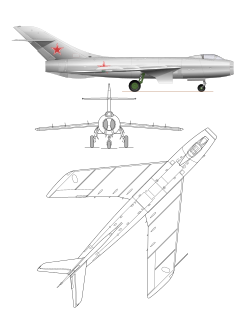Sukhoi Su-17 (1949)
| Sukhoi Su-17 (R) | |
|---|---|
 Drawing of the Su-17 |
|
| Type: | Fighter plane |
| Design country: | |
| Manufacturer: | |
| First flight: |
not happened |
| Production time: |
1949 |
| Number of pieces: |
1 prototype |
The Sukhoi Su-17 ( Russian Сухой Су-17 , project designation R ) was the name of a fighter aircraft project at the end of the 1940s . Had the machine been successfully tested, it would most likely have become the first mass -produced Soviet supersonic aircraft.
development
Pavel Sukhoi began construction work in 1948. He planned the Su-17 as a middle- wing aircraft with very strongly swept wings (50 °) and a very small fuselage cross-section. As a special rescue system, for the first time in the history of military aviation, the machine received a detachable nose section next to the catapult seat, which in the event of an emergency would have been separated from the aircraft by pyrotechnic charges and, together with the pilot , would have come to earth as an escape capsule on parachutes . A model was completed in December 1948 .
In the summer of 1949, flight tests were to begin, but the ZAGI , which was responsible for safety issues, refused to allow the Su-17 to operate because of concerns about the single-spar wings. Since the OKB Sukhoi had been dissolved around the same time , this aspect could no longer be changed and the Su-17 was handed over to the flight test institute of the aviation industry. A few more attempts were made there with the rescue system until the Su-17 was used for fire attempts and was destroyed in the process.
Pavel Sukhoi used the Su-17 as a template for the Sukhoi Su-7 , which marks the beginning of the well-known fighter-bomber series from the Sukhoi design office.
A swing-wing fighter-bomber was later given the serial designation Su-17 .
Technical specifications
| Parameter | Data |
|---|---|
| Conception | single-engine experimental supersonic fighter |
| Manufacturer | Sukhoi |
| Years of construction | 1948/49 |
| crew | 1 |
| length | 15.25 m |
| span | 9.95 m |
| height | 4.52 m |
| Wing area | 27.50 m² |
| Wing swept | 50 ° |
| Wing loading | 268.00 kg / m² |
| Empty mass | 6,240 kg |
| Takeoff mass | 7,890 kg |
| Top speed | 1,252 km / h near the ground 1,207 km / h at 5,000 m altitude 1,152 km / h at 10,000 m altitude |
| Rate of climb | 3.5 min at 10,000 m |
| Takeoff route | 460 m |
| Service ceiling | 14,500 m |
| Range | 1,080 km |
| Engine | a Ljulka TR-3 with axial compressor and afterburner |
| Start thrust | 46 kN |
| Armament | two 37 mm Nudelman N-37 cannons with 80 shells each |
See also
literature
- Wilfried Bergholz: Russia's great aircraft manufacturer . The complete type book. Jakowlew, Mikojan / Gurewitsch, Suchoj. Aviatec, Oberhaching 2002, ISBN 3-925505-73-3 , p. 172 .
- KJ Kosminkow: Suchoj Su-17: You could have been the first ... In: Flieger Revue . No. 3 . FlugVerlag Berolina, 1994, ISSN 0941-889X , p. 36-39 .
